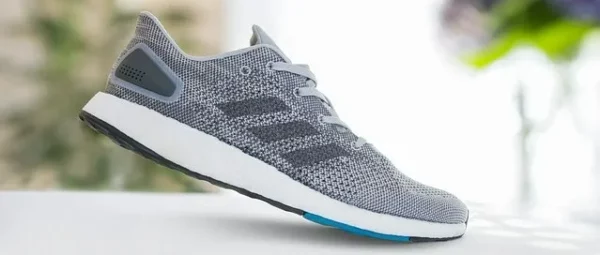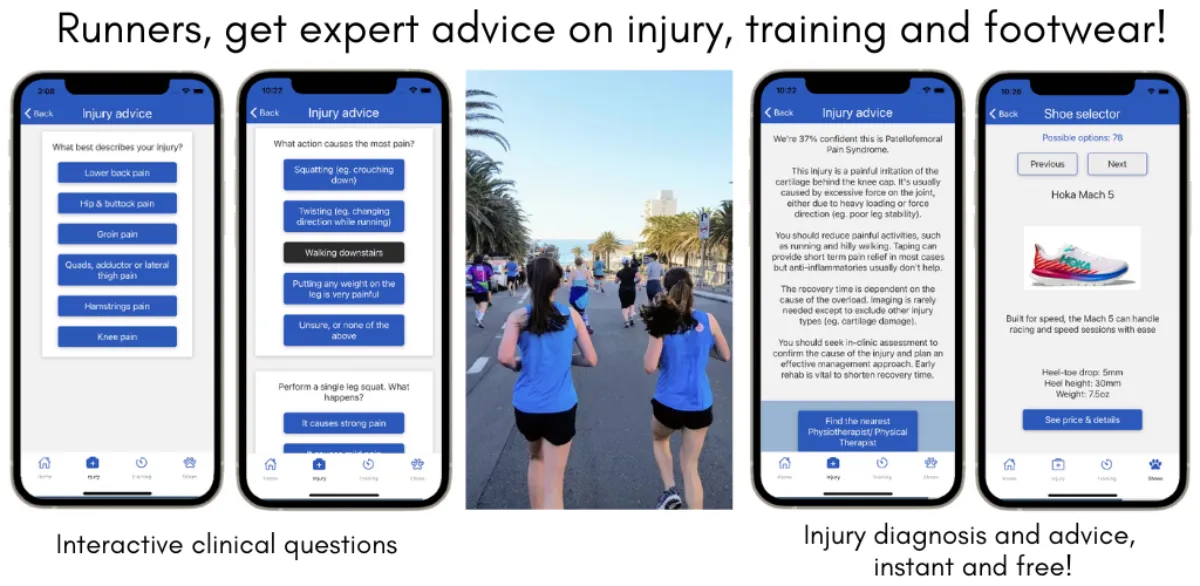In This Article
Finding the best running shoes for bad ankles can be a challenge – they all seem comfortable at first but that niggling ankle pain can creep back in after a few runs.
Bad ankles is a common issue that we see in distance runners. It’s not just a problem after having lots of rolled ankles, it can be due to unstable ankles, stiff hips and (not surprisingly) choosing the wrong shoes.
That last point is the critical one – can you choose better shoes to help relieve the ankle pain, or to help with your stability issues? Do you need more cushioned shoes or something more stable?

You also might be wondering if a maximalist shoe (eg. HOKA) can help or if you should dabble with carbon-plated shoes (because who doesn’t want to fly, right?).
Need expert advice to get the perfect shoe?
We’ve combined the expertise of a Sports Physiotherapist with a running coach to bring you accurate advice, for FREE!
This app, on Android and ios, offers expert advice on the perfect running shoes for you and your niggles.
The app can also diagnose injury and suggest running sessions that won’t flare up any current niggles.

Best running shoes for bad ankles divided into common injury types
Our Physiotherapists divided up this list of running shoes into different causes of bad ankles.
Impact loading (eg. Calcaneal Bone Stress)
Hoka One One Bondi
Stack height: 42mm, heel-toe offset: 4mm, weight: 315g(m)/286g(f)
Our recommendation: Hoka Bondi is the best maximalist cushioned running shoe on the market at the moment.
This shoe provides an extremely plush cushion under the heel. This protects it from impact forces when you land and will reduce pressure on the bone.
While they may be amongst the priciest shoes on the market, they’ll also the most popular option at big races like Hawaii Ironman in Kona.
They’re also one of the most popular and best running shoes for bad ankles for good reason!
Hoka Bondi’s aren’t cheap though, but you’re getting a durable shoe that feels amazing and can reduce bone loading.
We found the best prices for the Men’s range and Women’s range, as well as different width options.
Stability (eg. Tibialis Posterior Tendinopathy)
Asics Kayano
Stack height: 35mm, heel-toe offset: 10mm, weight: 317g(m)/260g(f)
Our recommendation: Kayano is best suited to runners who need genuine support in a high performance running shoe.
This popular shoe has been around forever. It provides a great amount of stability under the arch along with a comfortable feel.
That support reduces the speed of pronation (inwards movement of the ankle and downwards movement of the arch) during running, one of the main causes of Tibialis Posterior Tendinopathy.
For the biggest range of colors and options, have a look here for the Men’s range and Women’s range. They also come in a wide fit.
Saucony Guide
Stack height: 35mm, heel-toe offset: 8mm, weight: 269g(m)/235g(f)
Our recommendation: perfect for runners who like a light feel with mid-level support.
With growing popularity and improved materials, the Saucony Guide has the same level of support as the Kayano but the design fits narrow feet better.
Saucony’s Guide is getting more market share in recent years thanks to some recent design and material upgrades.
Also available in wide fit, you’ll find a broad range of Men’s shoes and Women’s shoes here.
Stability in runners with heavier foot strike (eg. Subtalar joint inflammation)
This category includes heavier runners AND those who land heavily, often destroying shoes within a few months.
Hoka One One Arahi
Stack height: 35mm, heel-toe offset: 5mm, weight: 264g(m)/218g(f)
Our recommendation: for Hoka fans who are looking for a plush shoe with a hint of support.
Hoka’s Arahi is available in a standard or wide fit and combines stability with the plush cushioning of the Bondi.
While it’s not as supportive as the Kayano or the Guide, it is much softer for heavy hitters. The support reduction is easily covered by the shock-absorbing midsole, making a great combination of comfort and stability assistance.
You can find Arahi’s in regular and wide fit for the Men’s range and Women’s range here.
Lack of dorsiflexion (eg. ankle arthritis or chronic ankle sprainers)
Asics GT-2000
Stack height: 31mm, heel-toe offset: 8mm, weight: 277g(m)/252g(f)
Our recommendation: one of the best all-rounders, for those who like a balanced mix of support and cushioning.
Ask any health professional about the best running shoes for bad ankles and the Asics 2000 is sure to be in their top 3!
This shoe is one of the world’s most popular for good reason. It has a generous heel-toe offset of ~10mm, a beautiful balance of stability and cushioning and it has a width option to suit almost any foot.
It covers all the bases, so it’s almost become the default shoe for anyone with a history of ankle issues.
The 2000s come is a big range of colors and widths, so have a look at the full range of Men’s and Women’s shoes.
Brooks Adrenaline
Stack height: 36mm, heel-toe offset: 12mm, weight: 289g(m)/249g(f)
Our recommendation: lighter and with more bounce than the previous version, they’ll suit runners looking for a comfortable cushy ride.
The Brooks Adrenaline has undergone a massive makeover in recent years. It’s no longer the clunky, heavy support shoe of the average runner – it’s now a sleek lighter shoe with a mix of performance and comfort.
To take on this new look, the Adrenaline has given up its stability pedigree and moved to a cushioned neutral shoe.
It’s still a great option for anyone with restricted ankle range, however you’d be better served by the Asics 2000 above if you need support as well.
Check out the range of Adrenalines in different colors and widths for the Men’s range and Women’s range here.
Unstable ankles on trail
Hoka One One Speedgoat
Stack height: 36mm, heel-toe offset: 4mm, weight: 280g(m)/246g(f)
Our recommendation: Speedgoat will suit trail runners looking for a responsive running shoe with great grip to use exclusively on trail.
One of Hoka’s newer models (although it’s now 5 years old), the Speedgoat is continuously evolving and improving.
It’s grippy but stable on trails, so it’s a lovely option for anyone who suffers from “weak ankles” on trails.
As a warning though, it’s also a lower drop shoe at ~5mm so it wouldn’t suit someone who has stiff or restricted ankles.
You’ll find a range of colors and wide fit options for the Men’s range and Women’s range here.
Salomon Speedcross
Salomon have made trail shoes since trail running was a thing, and that pedigree is obvious in the Speedcross.
Durable and tough, it’s got big lugs for grip and a ~10mm heel-toe offset to cater for anyone with stiff/restricted ankles.
The only downside to that grip is that it’s not suited to any road running, so don’t get these is every run is a road/trail combo.
It also has a Goretex version, but this isn’t suited to all conditions. It does very well in snow to avoid the cold dampness on the upper from soaking your socks. However, it won’t like creek crossings and pouring rain (collects water) and hot weather (prone to overheating).
Runners can find the latest Speedcross here, and the Goretex version here.
Disclaimer for Best Running Shoes for Bad Ankles
**Special note: this article has Physiotherapist-recommended products with affiliate links to trusted vendors, selected for their fast & reliable service and great prices. The article was written prior to sourcing the affiliate links and the links in no way influence our recommendations.


